
* The Beechcraft Corporation of Wichita, Kansas, was founded in 1932. It struggled along during the Depression years, mostly on the merits of the company's elegant Model 17 "Staggerwing" single-engine civil aircraft. Following the success of the Staggerwing, Beechcraft developed a civil twin aircraft, the "Model 18". It would not prove a great success until World War II came along, with thousands built for American and Allied forces. The Beech 18 remained successful in the postwar period, with thousands more built. This document provides a history and description of the Beech Model 18 -- as well as the "Beech AT-10" twin-engine trainer, and the experimental "XA-38 Grizzly" attack aircraft. A list of illustrations credits is included at the end.
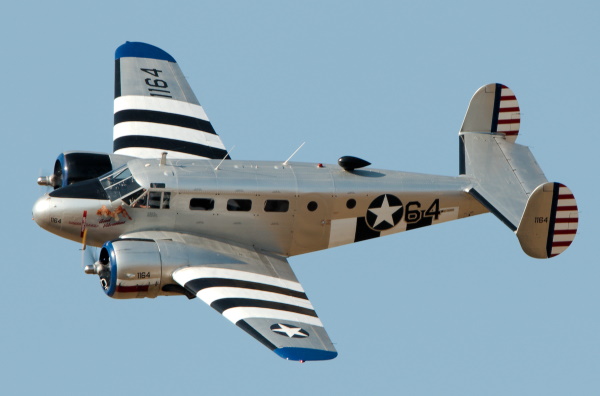
* In late 1935, the Beechcraft Corporation -- which had made a hit with its single-engine Model 17 Staggerwing luxury airplane -- began work on a light twin-engine utility transport for both civil and military use. Walter Beech and Ted Wells worked to come with the "Model 18", with the prototype performing its initial flight on 15 January 1937, with Homer Rankin and James Peyton at the controls, and initial customer delivery of the initial "Model 18A" in June of that year.
As it emerged, the Model 18 was a clean, low-wing design, with a twin-fin tail and retractable "taildragger" landing gear. It had a substantial resemblance to the bigger Lockheed Model 12 Electra Junior, but was hardly a copy, being completely different at the detail level. The Beech 18 was of all-metal construction -- aluminum skinning around a steel-tube frame -- except for fabric-covered ailerons, elevators, and rudder; the one-piece plain flaps were all-metal. All flight-control surfaces were manually actuated, except for electrically-actuated flaps. It was powered by twin Wright R-760-E2 7-cylinder air-cooled radial engine, with 240 kW (320 HP) each. The engines were in tight-fitting cowlings, with blisters over the cylinder heads; they drove twin-bladed variable-pitch constant-speed Hamilton Standard props. There were two fuel tanks in each wing, total capacity being 606 liters (160 US gallons); auxiliary fuel tanks were available as an option.
Each main landing gear assembly had a single wheel and retracted backwards electrically, the mainwheels remaining partly exposed after retraction. The Beech 18A could also be fitted with floats or skis, at which time it became an "S18A". Beech 18s with floats were not all that unusual. Aircrew included a pilot and copilot; the number of passenger seats was variable over the type's history, being given as 6, 7, 8, or 9. Six suggests three rows of two bucket seats each, 7 suggests a bench seat in the rear that could accommodate three passengers, while 8 and 9 suggests another seat row. Six or seven seats appear to have been the norm early on, given relatively low engine power.
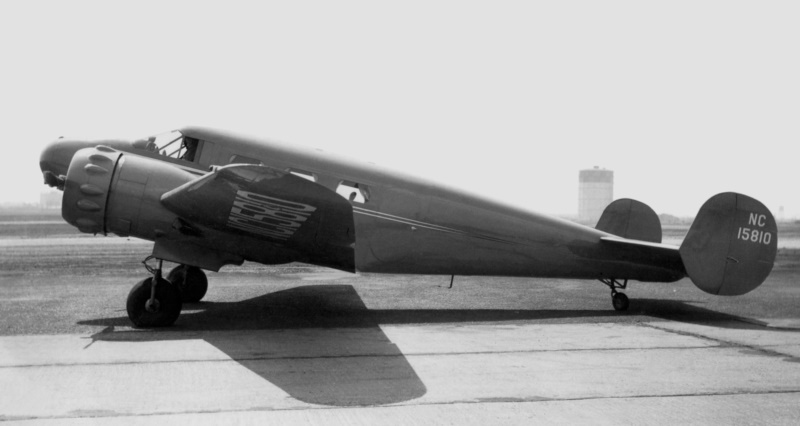
There was a forward-hinged door on the left rear fuselage, and three rectangular windows on each side. There was a baggage hold in the nose, and in the rear of the cabin. Incidentally, early on, the fabrics and colors in the interior were selected by Walter Beech's wife, Olive Ann -- who was a partner in the company, and in fact would become president after Walter's death.
The initial-series Model 18 was available with alternative powerplants:
None of them sold very well; the Model 18 was expensive, and wasn't quite what customers were after. The Jacobs engines were adopted as a cost-reduction measure -- but still, only 28 Model 18s were sold from 1937 to 1940. The company's engineers went back to the drawing board, with the first "Model 18S" rolled out at the end of 1939. After initial qualifications, the Model 18S won the McFadden Trophy, flying from Saint Louis MO to Miami FL on 6 January 1940, with an average speed of 377 KPH (234 MPH) -- zippy for the time.
The primary change was the introduction of the Pratt & Whitney (PW) 9-cylinder air-cooled R-985 Wasp Junior engine with 335 kW (450 HP) -- all the R-985 engine variants used on the Beech 18 had the same power ratings. The old tight cowlings with blisters gave way to a bigger and simpler cowling; it was easier to make, with no real penalty in performance. The tailfins and rudders were increased in size as well. Sources also mention "A18A", "A18D", and "B18S" subvariants that appear to have been generally identical to the 18S, with minor variations.
Of course, there were "Model S18S" float / ski variants of these machines as well. There was also a "Model 18R", which featured PW R-985-A1 engines with a two-stage supercharger. One was sold to Sweden as an air ambulance, while six were sold to Nationalist China as M18R light bombers -- featuring a glazed nose, a dorsal turret, and a flexible machine gun in the floor.
BACK_TO_TOP* By that time, the USA was gearing up for war, and the US military decided that the Model 18S would be a nice thing to have. The US Army Air Corps obtained it first, buying 14 as "F-2" photo-survey machines, with deliveries from December 1939. They were kitted up to carry cameras, with two mapping cameras in the floor, plus a port in the passenger door for oblique photography; they were powered by PW R-985-14 engines. The Air Corps bought 56 F-2s in all, including "F-2A" and "F-2B" machines, differing only in fit of R-985-AN3 or R-985-AN1 engines respectively. All surviving F-2, F-2A, and F-2B machines were redesignated "RC-45A" in 1948.
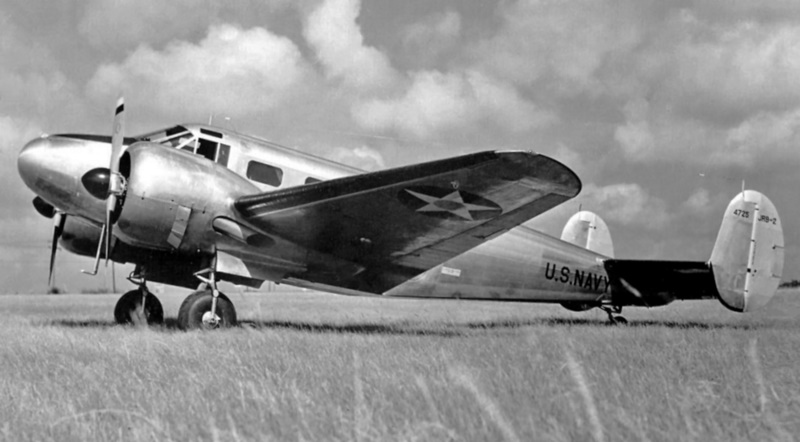
The F-2 going well, the Air Corps ordered 11 Model 18S machines as "C-45" 6-seat staff transports, then 20 as "C-45A" utility transports. They were followed by more purchases:
The C-45s were paralleled by the AT-7 series, mentioned above:
C-45F transports were also supplied under Lend-Lease to Britain's Royal Air Force as the "Expeditor I" (121 aircraft) and "Expeditor II" (303 aircraft), as well as to the Royal Canadian Air Force (RCAF) as the "Expeditor III" (55 Expeditors from RAF stocks). The British Royal Navy Fleet Air Arm also got 6 Expeditor Is and 48 Expeditor IIs. It appears all these were passed on from USAAF orders. It is not clear if the Americans or British came up with the name "Expeditor".
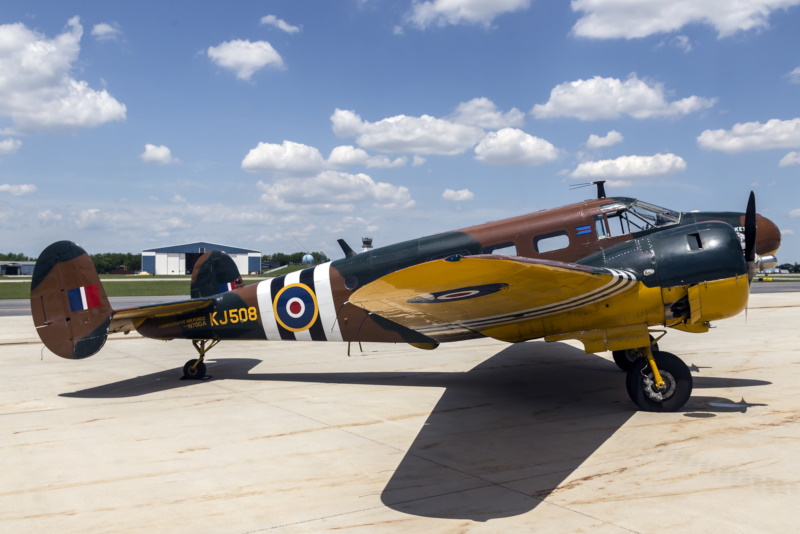
In addition, Beech produced a small number of C-45Fs late in the war for civil use as the "C18S" -- there wasn't supposed to be any civil aircraft production in the USA during the war, but these machines were intended as executive aircraft for big companies involved in the war effort.
___________________________________________________________________
BEECH C-45B:
___________________________________________________________________
wingspan:
14.53 meters (47 feet 8 inches)
wing area:
32.42 sq_meters (349 sq_feet)
length:
10.44 meters (34 feet 3 inches)
height:
2.95 meters (9 feet 8 inches)
empty weight:
2,670 kilograms (5,890 pounds)
MTO weight:
3,560 kilograms (7,850 pounds)
max speed at altitude:
345 KPH (215 MPH / 185 KT)
service ceiling:
6,095 meters (20,000 feet)
range:
1,125 kilometers (700 MI / 610 NMI)
___________________________________________________________________
The most heavily modified of the military Model 18s was the "AT-11 Kansan", which was a bomber trainer with a glass nose for a bombardier, and some fitted with an upper turret -- originally with one 7.62-millimeter (0.30-caliber) Browning machine gun, later with two -- with some also having a "tunnel gun" in the belly. In machines only used for bombardier training, in some cases the top turret was replaced by a plexiglas dome. The AT-11 had a bomb bay for up to ten 45-kilogram (100-pound) practice bombs, and small circular porthole fuselage windows. 1,902 AT-11s were built for USAAF orders. 36 of them were converted to navigation trainers, to become "AT-11A" machines.
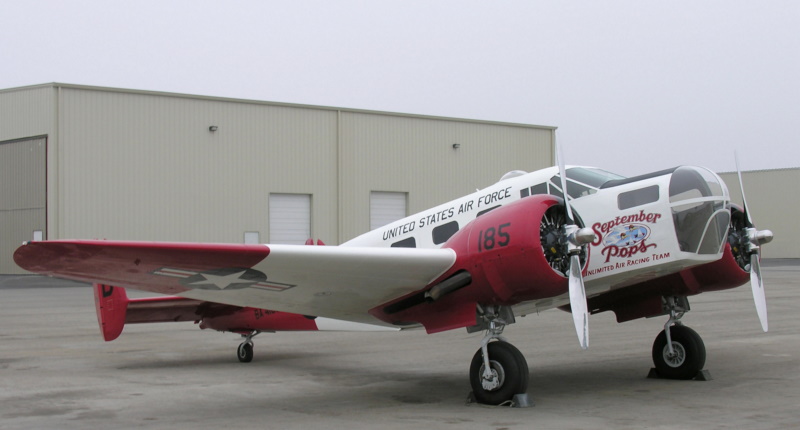
The US Navy & Marines also obtained the Beech 18 during the war, in a series of variants that didn't exactly parallel the variants for the USAAF:
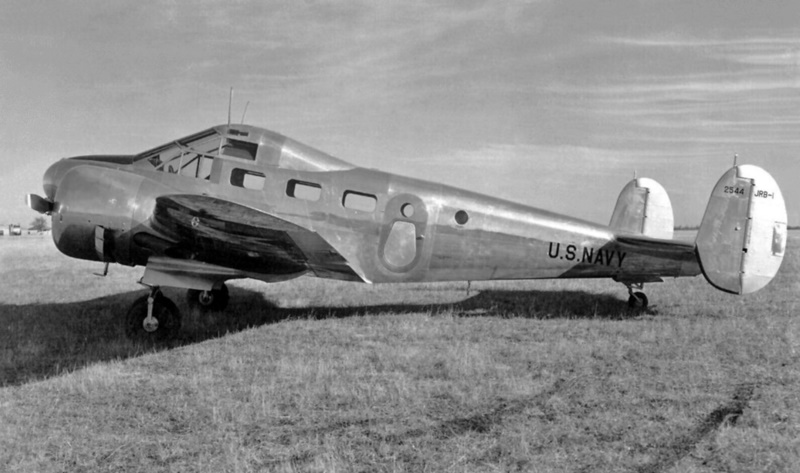
There's a report that, it seems during the war, at least one Model 18 was experimentally fitted with PW R-1340 9-cylinder radials with 445 kW (600 HP) each. It was too much power for the airframe, and nothing came of the fit.
BACK_TO_TOP* The Model 18 was highly satisfactory in service, being sturdy and pleasant to fly, though the controls were a bit heavy. Apparently it was often called the "Twin Beech", though that name obviously went out of style as other Beech twins were introduced. Many war-surplus Beech 18s ended up in civil hands, notably as executive aircraft, short-haul airliners, or light freight haulers -- but they would also be used in other roles, such as air ambulance, skydiving, testbeds, or drug smuggling. However, the military hadn't given up on the type by any means.
In 1947, Beech introduced the "Model D18S", which had Wasp engines in more streamlined nacelles; and had higher max operating weight, the airframe being reinforced to handle the higher weights. Only 31 Model D18S machines were built, but it was the basis for further military sales. 280 were built for the RCAF, operating in a number of roles:
Along with new-production model D18S machines, in the early 1950s Beech rebuilt a large number of AT-7s and AT-11s to D18S specification for the US Air Force (USAF) -- the USAAF having become a separate service in 1947. The rebuilds included:
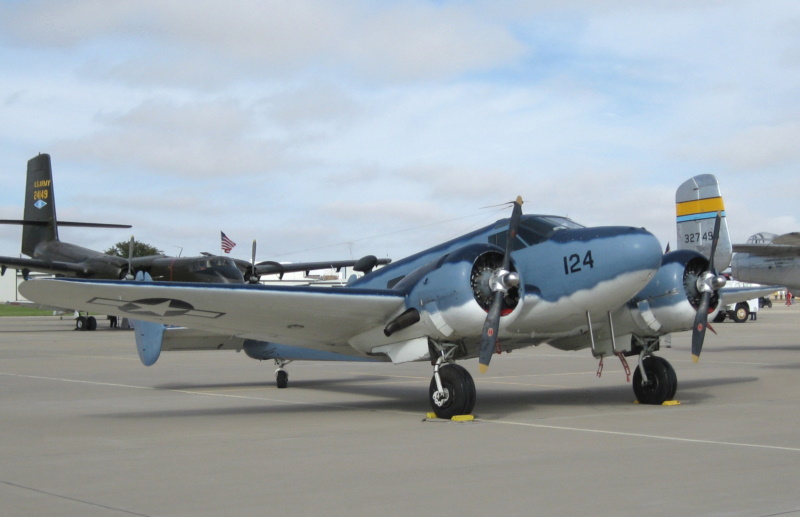
The US Navy similarly performed a number of updates, the result being "SNB-5" utility / trainer machines, and "SNB-5P" photo-reconnaissance machines. There was also an "SNB-3Q" electronic countermeasures trainer, at least one converted from SNB-2; and some partial updates of JRB-3 and JRB-4 machines designated "JRB-6". In 1962, when the Pentagon acquired common designation schemes, utility machines were redesignated "UC-45J", trainers became "TC-45J", and photo machines became "RC-45J".
* Following the Model D18S, in 1946 Beech introduced the "D18CT", which was a D18S configured as a small commercial airliner with 8 or 9 seats; there was also the "D18C", which was the same, but with an executive interior. It was powered by Continental R-9A engines with 390 kW (525 HP) each; the R-9A was a license-built Wright R-975 Whirlwind, making this the only Model 18 variant to have a Wright engine after the original Model 18. Only 31 D18C/CT machines were built.
The "Model E18S" was introduced in 1955; it was the first "Super 18", with the cabin roof raised by 15 centimeters (6 inches) for more headroom, and a larger "airstair" door. It also featured extended, squared-off wingtips. Some images show them with double cargo doors; it is unclear if they were a factory option, or a later fit. There was also a "Model E18S-9700" with MTO weight raised to 4,400 kilograms (9,700 pounds), from 4,200 kilograms (9,300 pounds), and three-bladed Hartzell propellers. 451 E18S-series machines were produced; a number of earlier machines were also rebuilt with the raised cabin.
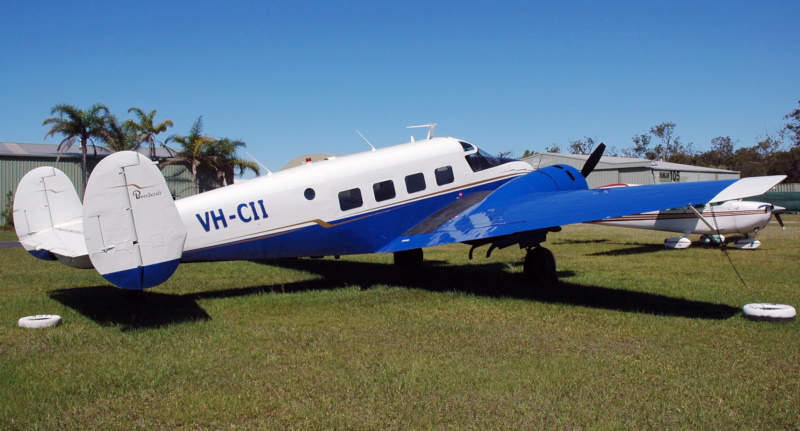
The "Model G18S" was a Beech E18S with a two-piece larger windshield, an extended side window on each side of the fuselage, and three-bladed props as standard. There was also a single reduced-weight "Model G18S-9150" with MTOW trimmed down to 4,150 kilograms (9,150 pounds). 154 G18S-series machines were built in all.
___________________________________________________________________
BEECH MODEL G18S SUPER 18:
___________________________________________________________________
wingspan:
15.15 meters (49 feet 8 inches)
wing area:
33.51 sq_meters (360.7 sq_feet)
length:
10.74 meters (35 feet 2 inches)
height:
2.95 meters (9 feet 8 inches)
empty weight:
2,700 kilograms (5,950 pounds)
MTO weight:
4,400 kilograms (9,700 pounds)
max speed at altitude:
345 KPH (235 MPH / 200 KT)
service ceiling:
6,400 meters (21,000 feet)
range:
2,550 kilometers (1,585 MI / 1,380 NMI)
___________________________________________________________________
The last of the line was "Model H18", introduced in 1963, featuring optional tricycle landing gear developed by the Volpar company, as well as more fuel, air conditioning, new lightweight three-bladed props, and higher MTOW of 4,490 kilograms (9,900 pounds). 149 were built, including 109 with tricycle landing gear, while 240 older machines were updated to the tricycle landing gear. The final Beech H18 was rolled out in 1970, over 8,000 Model 18s having been built in all.
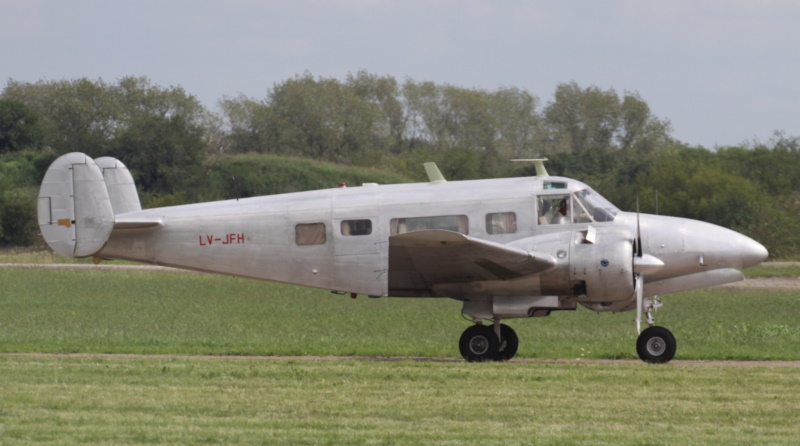
The C-45 flew in USAF service until 1963, the USN retired its last Model 18 in 1972, while the US Army flew its C-45s until 1976 -- some of the Army Model 18s having been updated with Volpar tricycle landing gear. The Model 18 saw extensive service with Air America, a CIA flight-support company, during the Vietnam. Initially, Air America flew ex-military Model 18s, but then obtained custom conversions:
Along with the tricycle conversions of the Model 18 and the Turbo Beech, Volpar came up with a "Super Turbo 18", with uprated TP-331 engines providing 525 kW (705 HP); and the "Turboliner", being a Super Turbo stretched to provide 15 passenger seats. Other companies performed conversions as well:
A photo survives of a Beech 18 that retained its radials but had a fit of a turboprop in the nose, making it a "tri-motor". It was flown in the early 1960s by Pratt & Whitney Canada, operating from Toronto, for evaluation of the company's new PT6A engine.
The Beech 18 was flown during and after World War 2 by the military forces of Argentina, Bolivia, Brazil, Britain, Canada, Chile, Colombia, Costa Rica, Cote d'Ivoire, Dominican Republic, Ecuador, El Salvador, France, Guatemala, Haiti, Honduras, Indonesia, Iran, Italy, Japan, Mexico, Netherlands, Nicaragua, Niger, Nigeria, Paraguay, Peru, Philippines, Portugal, Somalia, South Africa, South Vietnam, Spain, Sri Lanka, Sweden, Switzerland, Taiwan, Thailand, Tonga, Turkey, Uruguay, Venezuela, and Zaire. Several dozen are still flying.
BACK_TO_TOP* In 1940, the Army Air Corps issued a request for a basic, low-cost multi-engine trainer -- to be made out of non-strategic materials, there being worries about an aluminum shortage. Beechcraft responded with a design for the "Model 25", which was of largely wooden construction, building a prototype that was handed over to the USAAC for evaluation.
The Model 25 prototype was lost in a crash on 5 May 1941. That didn't end the program, with Beechcraft then developing an improved "Model 26", which performed its first flight on 19 July 1940. It proved satisfactory, with the USAAF awarding Beech a series of production contracts. It went into service in early 1942 as the "AT-10".
The AT-10 has been called a "wooden Beech 18", but it had only a broad configurational resemblance to the Model 18 -- being a low-wing monoplane with twin radial engines and taildragger landing gear. It differed significantly from the Model 18 by having a single instead of twin tail. The only metal assemblies in the airframe were the cabin enclosure and the engine cowlings. The wooden construction allowed fabrication of sub-assemblies to firms such as furniture makers. The landing gear, like that of the Model 18, featured main gear with single wheels, retracting hydraulically back into the engine nacelles.
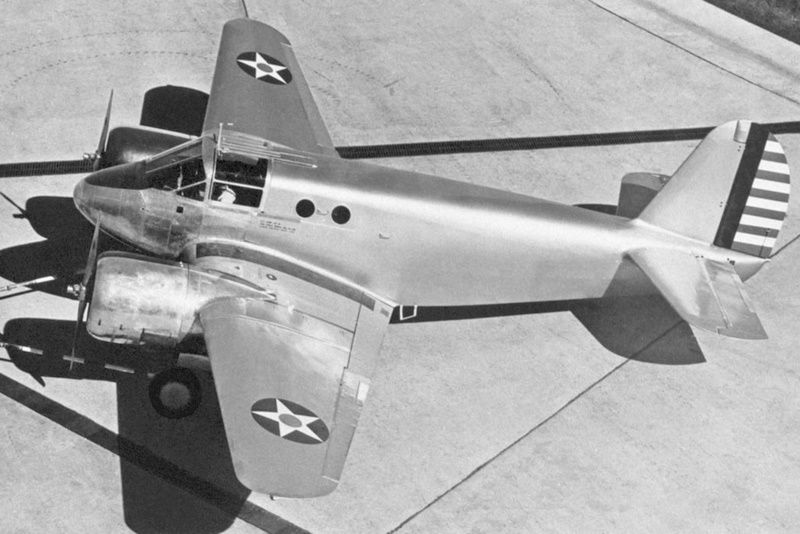
It was powered by twin Lycoming R-680-9 nine-cylinder radials, providing 220 kW (295 HP) each, driving two-bladed variable-pitch propellers. Even the fuel tanks were made of wood -- lined with neoprene, a synthetic rubber. It had seats for pilot and instructor, who got in and out via side windows. There were two portholes on both sides of the fuselage behind the cockpit, suggesting a space behind the cockpit, but it is not clear if the AT-10 ever flew with rear seats.
___________________________________________________________________
BEECH AT-10 WICHITA:
___________________________________________________________________
wingspan:
13.41 meters (44 feet)
wing area:
298 sq_meters (27.7 sq_feet)
length:
10.46 meters (34 feet 4 inches)
height:
3.15 meters (10 feet 4 inches)
empty weight:
2,155 kilograms (4,750 pounds)
MTO weight:
2,780 kilograms (6,130 pounds)
max speed at altitude:
172 KPH (200 MPH / 320 KT)
service ceiling:
5,150 meters (16,900 feet)
range:
1,240 kilometers (770 MI / 670 NMI)
___________________________________________________________________
Beech produced 1,771 AT-10s at Wichita to 1943, with Globe Aircraft (later Temco) then building another 600 in Dallas TX to 1944 -- with 2,371 AT-10s were built in all. The AT-10 didn't have much service after the war; it had little utility as anything but a trainer, and its wooden construction wasn't intended for long-term use. One was used to evaluate the "vee-tail", used on early models of the Beech Bonanza light civil aircraft.
* In 1942, the USAAF was searching around for a new ground-attack aircraft to replace the Douglas A-20, awarding a contract to Beech in December of that year for two prototypes of the Model 28 "Destroyer". Initial flight of the first prototype, by then known as the "XA-38 Grizzly", was on 7 May 1944, with Beech test pilot Vern Carstens at the controls.
It had much the same general configuration as the Model 18, including the twin tail and taildragger landing gear, but was scaled up. It was fitted with a 75-millimeter cannon in the nose, with a munitions load of 20 rounds. It also had two 12.7-millimeter meter (0.50 caliber) Browning machine guns, firing forward in the nose. The nose assembly was modular, hinging up for easy access, allowing replacement by other noses with different armament fits. Defensive armament consisted of top and bottom remote-controlled turrets, both with twin Brownings; they could be turned forward to be fixed in place, and fired by the pilot. Apparently, it had provisions for belly and underwing stores, including drop tanks, bombs, a torpedo, or unguided rockets.
It was powered by twin Wright R-3350-43 Duplex Cyclone 18-cylinder two-row air-cooled radials, with 1,715 kW (2,300 HP) each, driving 3-bladed, variable pitch Hamilton Standard propellers. Aircrew consisted of a pilot in front and an observer-gunner facing backwards in the rear, the gunner using periscopic sights.
___________________________________________________________________
BEECH XA-38 GRIZZLY:
___________________________________________________________________
wingspan:
20.52 meters (67 feet 4 inches)
wing area:
58.15 sq_meters (626 sq_feet)
length:
15.77 meters (51 feet 9 inches)
height:
4.72 meters (15 feet 6 inches)
empty weight:
10,195 kilograms (22,480 pounds)
MTO weight:
15,995 kilograms (35,265 pounds)
max speed at altitude:
595 KPH (370 MPH / 322 KT)
service ceiling:
8,840 meters (29,000 feet)
range:
2,615 kilometers (1,625 MI / 1,415 NMI)
___________________________________________________________________
The Grizzly was an excellent aircraft, with performance like that of a single-engine fighter, as well proving reliable and serviceable. However, the program was abandoned after the second prototype was completed. The Wright R-3350 engines were needed for the Boeing B-29 Superfortress, bomber, which had priority. In addition, Douglas had developed their own replacement for the A-20, the "A-26 Invader", which rendered the XA-38 somewhat redundant.
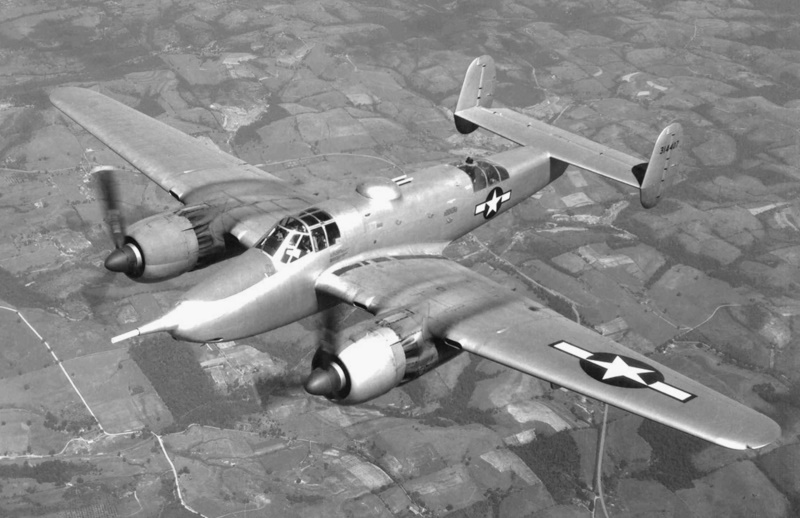
Although the evaluation of the Grizzly was very positive, the A-26 seemed able to do the job, and the Boeing B-29 Superfortress competed with the Grizzly for the R-3350 engines. Only the two prototypes were built, with both apparently scrapped.
BACK_TO_TOP* Sources include:
Wikipedia and other online sources were scavenged for what details I could find. As is often the case with civil aircraft, the Beech 18 is not over-documented.
* Illustrations credits:
* Revision history:
v1.0.0 / 01 mar 22 v1.0.0 / 01 feb 24 / Review & polish.BACK_TO_TOP
